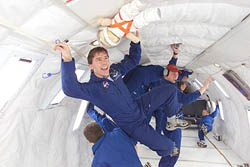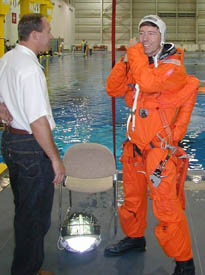Alum Trains for International Space Station Duty
Michael R. Barratt, MD, ’85, GME ’88, is in Star City, Russia, training for a six-month mission on the International Space Station. In this e-mail interview, he provides insight into the world of a medical professional who is also a space traveler.
 |
| Astronaut Dr. Michael Barratt trains for duty on the International Space Station by experiencing weightlessness aboard a zero gravity aircraft, also known as the “Vomit Comet.” A doll named Sally (after Sally Ride, the first American women to orbit the earth) floats nearby. When Dr. Barratt’s daughter was born, she received the doll from the Northwestern obstetrician who delivered her. |
What spurred your interest in space medicine?
Space medicine involves a unique combination of many things I love. Aside from the direct medical aspect, this includes flying, diving, research, training in broad areas of science from geology to radiation physics, travel, and, of course, working with some really talented folks.
The medicine practiced in support of space flight is geared toward healthy and fit people in extreme environments, and it is tremendous fun to learn about the environments and determine ways to optimize human performance in them. Most people think only of space flight, but astronauts are also aviators all are required to fly as pilots or flight engineers in high-performance jet aircraft. For most of us this means the T-38, a twin engine supersonic Air Force trainer. In addition, astronauts are required to maintain scuba certification related to underwaterextravehicular activity (EVA) training and undergo wilderness survival and team training exercises. So the field encompasses aspects of aviation, diving, and expeditionary medicine.
Space flight itself and the changes the human body undergoes during adaptation to weightlessness are also interesting. The physiology of this is in its early stages of characterization but is quite exciting. Many changes need to be taken into account as you consider countermeasures to the deleterious effects of weightlessness or treatment for an ailment that might present differently against the backdrop of this adaptive physiology. In essence, astronauts are extraterrestrials, and along with the physiological changes undergo anatomical and anthropometric changes.
Add to this the challenges of practicing standard medicine in space, where you are limited by shelf life,
volume, weight, and power. Items must be easy and intuitive to use, since a physician is seldom on
board. We practice extreme telephone medicine, whereby crew members may connect with a flight surgeon at [the] Mission Control [Center]. Typically, the flight surgeon assigned to a mission will have played a major role in training the crew for medical events and periodically speaks to the crew over private channels. Weightlessness adds its own twists everything must be restrained, you cannot “hang” an intravenous infusion bag, and don’t even look for air fluid levels on diagnostic imaging studies. Medicine can’t get much more exciting than that! Oh yeah, Dr. “Bones” McCoy [from the television series Star Trek] was one of my childhood heroes.
Tell us what your space flight training is like.
It’s rather like being a perpetual grad student. We spend most of our first couple of years in classrooms. After the fundamental curriculum of basic sciences, space shuttle [systems], and station systems, much time is spent in simulators and the pool. Training becomes much more hands on and interesting. Astronauts also maintain technical job assignments, which vary in their “busy-ness” factors.
Since I am training for work aboard the International Space Station, time is spent overseas learning about Japanese, European, Canadian, and Russian modules and systems. Two transport spacecraft go to the space station the U.S. Shuttle and Russian Soyuz. The main training centers and mission control centers are in Houston and in Star City and Korolev, Russia. Crews must be functionally bilingual, speaking English and Russian, which adds another element to the training.
Physically, we are required to pass annual fitness exams, and a group of mildly sadistic sports and exercise trainers familiar with our work try to ensure this. EVA training and actual performance are among the more physically demanding activities. The space suits are heavy, and you are always working against the pressure of the suit along with exerting loads and moving massive objects. Particular programs of aerobic and upper body conditioning target these activities. If you are in shape for this, you can handle most of the flying, diving, survival, and expeditionary training demands. By the way, as I write this I am preparing to depart Moscow for Sevastopol on the Black Sea for sea survival training in the event a spacecraft inadvertently lands in the water.
What will be your main responsibility(ies) on the space station?
I am training to fly as a flight engineer on the Russian Soyuz spacecraft, so much of my training is geared toward this. You can think of this as the commute to and from the station, but of course it is a fairly exciting ride each way. For each ride to the station, be it in the Russian ward rounds fall 2007 33 Soyuz or the U.S. Shuttle, you spend an inordinate amount of time training for the ascent and landing, since that is the most critical “hands on” phase of space flight. Between the launch and landing, I will spend about six months aboard the station. First and foremost I will be a generic flight engineer, responsible for assembly and maintenance tasks, EVA, and robotics operations.
The International Space Station is a fairly complex platform. A good deal of time each day is spent maintaining and servicing the life support, thermal control, electrical power, and other systems. Aside from this, each crew member must exercise for about two hours daily to minimize effects of weightlessness. Much time also will be spent on science payloads, including medical research. Typically two crew members on board are trained as medical caregivers, and I will by default be one of these. I helped devise the medical system on the space station in my years as a flight surgeon, so this will be an interesting field test.
What effect does space travel have on the human body?
 |
| Wearing a shuttle launch and entry suit, Dr. Barratt prepares for an exercise to simulate a “bail-out” over water. The exercise involves being dropped into the water and evaluated on the ability to jettison a parachute, deploy and enter a life raft, and use all survival gear. |
It has many effects, most related to weightlessness. When in an “unloaded” state as opposed to a state affected by Earth’s gravity, the body adapts by “down regulating” functions that are not used frequently. Muscle mass is lost, particularly from postural muscles and lower extremities, as well as bone mineral density, both related to the unloading of forces that normally shape maintenance and modeling of tissue structure. The ability to regulate blood pressure during gravitational challenges, such as standing up from a sitting or recumbent position, is largely compromised after a few days in space, let alone six months.
Aerobic capacity decreases, and most crew members lose four or five kilograms of lean body mass before achieving a new steady state. Body fluid regulation changes, and blood volume typically decreases 10 15 percent. Neurovestibular regulation and reactivity to positional challenges are significantly downgraded after several months in space. Other changes also occur but are mostly adaptive and don’t bother you during flight. They mainly become problematic, or maladaptive, when you return to Earth and have to readapt to loads again.
Characterizing both adaptation to weightlessness and readaptation to gravity is another task. We have learned about aspects of basic human physiology by subtracting gravity as an omnipresent factor. Also, when people first go to Mars, it will likely follow a long period of weightlessness during the trip out. Astronauts landing on the surface will not have medical specialists to help them. We will need to have well developed methods of assessment, readaptation, and regaining of performance to allow crew members to get out of their ships and explore the surface.
The one big bogey of spaceflight is radiation. While not producing symptoms or influencing adaptation or performance, earth orbit is very much a radiation environment due to particles trapped in the geomagnetic fields, galactic cosmic rays, and solar particles. Astronauts are classified as radiation workers, and we monitor accumulated doses exhaustively. The major medical risk is increased cancer risk. All of this gets worse as you leave Earth’s vicinity for the Moon or Mars. Developing effective radiation shielding and other protective measures are among the highest life sciences priorities in human space flight.
Posted November 30, 2007. Excerpted from the Fall 2007 issue of Ward Rounds.






